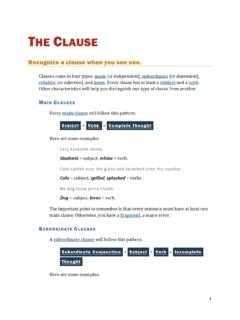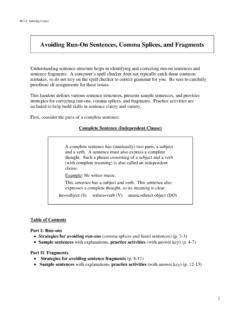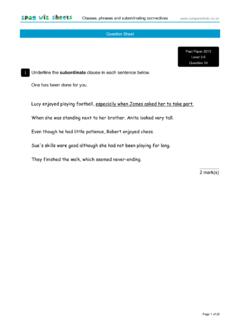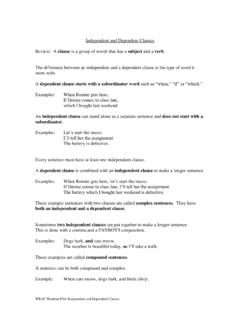Transcription of Engineer Ops BCT and Below - United States Army
1 ATP Engineer OPERATIONS BRIGADE COMBAT TEAM AND Below APRIL 2021 DISTRIBUTION RESTRICTION: Approved for public release; distribution is unlimited. This publication supersedes ATP , dated 5 December 2014. Headquarters, Department of the army This publication is available at the army Publishing Directorate site ( ) and the Central army Registry site ( ). *ATP RESTRICTION: Approved for public release; distribution is unlimited. *This publication supersedes ATP , dated 5 December i army Techniques Publication No. 3- Headquarters Department of the army Washington, , 14 April 2021 Engineer OPERATIONS BRIGADE COMBAT TEAM AND Below Contents Page iv INTRODUCTION .. v Chapter 1 Engineer SUPPORT TO THE BRIGADE COMBAT TEAM.
2 1-1 SECTION I Operational Overview .. 1-1 Operational Environment .. 1-1 Specific Terrain Considerations .. 1-2 Understanding the Threat .. 1-3 Understand, Shape, Influence, and Consolidate Gains .. 1-5 Large-Scale Combat Operations .. 1-9 Combined Arms .. 1- 10 Hasty Versus Deliberate Operations .. 1- 10 Engineer Considerations for Information Collection .. 1- 11 Section II Brigade Combat Team Engineer Support 1- 11 Brigade Combat Team Engineer Staff Organization .. 1- 11 Assistant Brigade Engineer Section .. 1- 12 Brigade Combat Team Geospatial Engineer Team .. 1- 14 Brigade Engineer Battalions .. 1- 15 Echelon Above Brigade Enablers .. 1- 15 Sister Service Engineer Capabilities .. 1- 16 Chapter 2 BRIGADE Engineer BATTALIONS.
3 2-1 Section I Brigade Engineer Battalion Types and 2-1 Brigade Combat Team .. 2-1 Brigade Engineer Battalion .. 2-2 Battalion Headquarters and Staff .. 2-3 Headquarters and Headquarters Company .. 2-6 Section II Brigade Engineer Battalion Company Structures .. 2-7 Engineer Companies .. 2-8 Military Intelligence 2-9 Brigade Signal Company .. 2- 10 Forward Support Company .. 2- 13 Chapter 3 Command and Control .. 3-1 SECTION I COMMAND AND CONTROL OVERVIEW .. 3-1 Command and Support Relationships .. 3-2 Contents ii ATP 14 April 2021 Command and Control Systems .. 3-5 Brigade Enabler management .. 3-6 SECTION II ECHELON ABOVE BRIGADE Engineer ENABLERS .. 3-8 Engineer Headquarters Units .. 3-8 Baseline and Specialized Engineer Units.
4 3-9 SECTION III NONENGINEER BRIGADE COMBAT TEAM ENABLERS .. 3- 12 Military Police Companies .. 3- 13 Chemical, Biological, Radiological, and Nuclear Companies .. 3- 13 Civil Affairs Companies .. 3- 13 Explosive- Ordnance Disposal Companies.. 3- 13 Military Information Support Operations .. 3- 13 Air Defense Units .. 3- 14 Chapter 4 Engineer SUPPORT TO COMBAT .. 4-1 Section I Engineer Support During Shape and Prevent operations .. 4-1 Support to Command and Control .. 4-1 Missions to Set the Theater .. 4-2 Section II Large-Scale Combat Operations .. 4-5 Offensive Missions .. 4-6 Forms of Maneuver .. 4-9 Enabling 4- 14 Defensive 4- 14 Engineer Support to Select Warfighting Functions .. 4- 20 Section III Engineer Support to Consolidate Gains.
5 4- 23 Transitions .. 4- 24 Engineer Support to Stability .. 4- 25 army Stability Operations .. 4- 25 Engineer Stability Missions by Warfighting Function .. 4- 28 Engineer Support to Foreign Security Forces .. 4- 30 Engineer Support to Defense Support to Civil Authorities .. 4- 31 Chapter 5 TASK FORCE ENGINEERS AND Engineer PLANNING .. 5-1 Section I Brigade Combat Team Engineers and Task Force Engineer Roles and Responsibilities .. 5-1 The Brigade Engineer .. 5-1 Task Force Engineer Roles and Functions .. 5-2 Command and Staff Responsibilities .. 5-3 Integration Techniques for the Task Force Engineer .. 5-4 Task Force Engineer Integration Considerations .. 5-5 Section II Engineer Planning .. 5-6 The Framework of the Operations Process.
6 5-7 Integrating Processes .. 5- 10 Engineer Running Estimate .. 5- 15 Analysis of the Higher-Headquarters Order .. 5- 17 Fundamentals of Execution .. 5- 21 Engineer Plans, Orders, and 5- 22 Command Post Functions .. 5- 23 Chapter 6 SUSTAINMENT CONSIDERATIONS .. 6-1 Sustainment Planning .. 6-1 Logistics .. 6-2 Engineer Sustainment Planning Considerations .. 6-3 Brigade Engineer Battalion Staff Sustainment Tasks .. 6-5 Forward Support Company Capabilities .. 6-6 Integration into the Local Sustainment Enterprise .. 6- 11 Contents 14 April 2021 ATP iii GLOSSARY .. Glossary-1 REFERENCES .. References-1 INDEX .. Index-1 Figures Figure 1-1. Conflict continuum and the range of military operations .. 1-2 Figure 2-1. BEB 2-3 Figure 2-2.
7 BEB Engineer companies .. 2-9 Figure 2-3. MICO organization .. 2- 10 Figure 2-4. Brigade signal company organizational structure .. 2- 10 Figure 3-1. Combat power model .. 3-2 Figure 4-1. Engineer missions across warfighting functions .. 4-2 Figure 4-2. Base camp development planning process .. 4-4 Figure 4-3. Reverse breach planning process supporting a frontal 4- 12 Figure 4-4. army stability operations tasks .. 4- 26 Figure 5-1. The operations process .. 5-7 Figure 5-2. Data flow to an understanding .. 5- 23 Figure 6-1. BCT notional concept of support .. 6- 11 Tables Table 3-1. Command relationship matrix .. 3-3 Table 3-2. army support relationships .. 3-4 Table 3-3. Other relationships .. 3-5 Table 3-4. Operating force engineers.
8 3-9 Table 5-1. Engineer roles and responsibilities by echelon .. 5-3 Table 5-2. Engineer planning integrated across warfighting functions .. 5-8 Table 5-3. Inputs and outputs for the seven steps of MDMP .. 5- 11 Table 5-4. Engineer considerations in MDMP .. 5- 12 Table 5-5. Correlation of mission analysis and the Engineer running estimate .. 5- 16 Table 5-6. Elements of decisive action .. 5- 17 Table 5-6. Elements of decisive action (continued) .. 5- 18 iv ATP 14 April 2021 Preface ATP provides a doctrinal foundation for the conduct of Engineer operations in support of unified land operations, focused on tactical maneuvers at the brigade combat team (BCT) level and Below . The Engineer organizations organic to the BCT are optimized to perform combat engineering tasks (primarily mobility with limited capabilities in countermobility and survivability), with geospatial engineering teams providing organic capability.
9 Additional engineering support (combat and general) comes from Engineer organizations that are task-organized to the BCT or that provide support from echelons above brigade (EAB) organizations. This manual is aligned with current BCT doctrine (see FM 3-96) and describes Engineer support for the armored brigade combat team (ABCT), infantry brigade combat team (IBCT), and Stryker brigade combat team (SBCT). Although the security force assistance BCT and its respective Engineer battalions are not addressed in detail, the basic principles of this manual also apply to those organizations. The principal audience for ATP consists of commanders, officers, noncommissioned officers (NCOs) , and staff at the BCT level and Below as well as EAB units that support BCTs.
10 ATP is a primary manual for instructional purposes within the United States army Engineer School and assists other army branch schools in teaching the integration of Engineer capabilities into army operations. Commanders, staffs, and subordinates ensure that their decisions and actions comply with applicable United States , international, and in some cases host-nation laws and regulations. Commanders at all levels ensure that their Soldiers operate in accordance with the law of war and rules of engagement. (See FM 6-27.) ATP uses joint terms where applicable. Selected joint and army terms and definitions appear in both the glossary and the text. Terms for which ATP is the proponent publication (the authority) are marked with an asterisk (*) in the glossary.
















